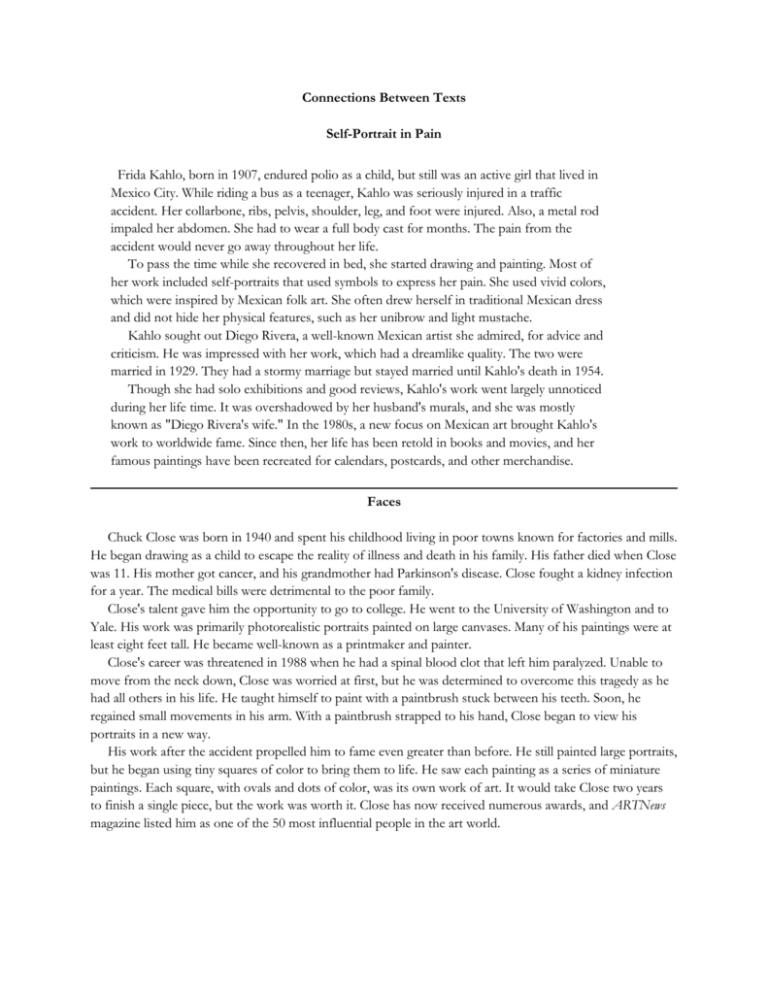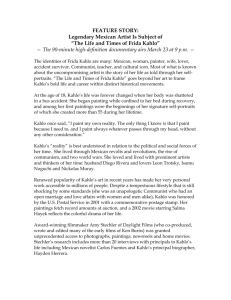Connections Between Texts Self-Portrait in Pain Frida Kahlo, born in
advertisement

Connections Between Texts Self-Portrait in Pain Frida Kahlo, born in 1907, endured polio as a child, but still was an active girl that lived in Mexico City. While riding a bus as a teenager, Kahlo was seriously injured in a traffic accident. Her collarbone, ribs, pelvis, shoulder, leg, and foot were injured. Also, a metal rod impaled her abdomen. She had to wear a full body cast for months. The pain from the accident would never go away throughout her life. To pass the time while she recovered in bed, she started drawing and painting. Most of her work included self-portraits that used symbols to express her pain. She used vivid colors, which were inspired by Mexican folk art. She often drew herself in traditional Mexican dress and did not hide her physical features, such as her unibrow and light mustache. Kahlo sought out Diego Rivera, a well-known Mexican artist she admired, for advice and criticism. He was impressed with her work, which had a dreamlike quality. The two were married in 1929. They had a stormy marriage but stayed married until Kahlo's death in 1954. Though she had solo exhibitions and good reviews, Kahlo's work went largely unnoticed during her life time. It was overshadowed by her husband's murals, and she was mostly known as "Diego Rivera's wife." In the 1980s, a new focus on Mexican art brought Kahlo's work to worldwide fame. Since then, her life has been retold in books and movies, and her famous paintings have been recreated for calendars, postcards, and other merchandise. Faces Chuck Close was born in 1940 and spent his childhood living in poor towns known for factories and mills. He began drawing as a child to escape the reality of illness and death in his family. His father died when Close was 11. His mother got cancer, and his grandmother had Parkinson's disease. Close fought a kidney infection for a year. The medical bills were detrimental to the poor family. Close's talent gave him the opportunity to go to college. He went to the University of Washington and to Yale. His work was primarily photorealistic portraits painted on large canvases. Many of his paintings were at least eight feet tall. He became well-known as a printmaker and painter. Close's career was threatened in 1988 when he had a spinal blood clot that left him paralyzed. Unable to move from the neck down, Close was worried at first, but he was determined to overcome this tragedy as he had all others in his life. He taught himself to paint with a paintbrush stuck between his teeth. Soon, he regained small movements in his arm. With a paintbrush strapped to his hand, Close began to view his portraits in a new way. His work after the accident propelled him to fame even greater than before. He still painted large portraits, but he began using tiny squares of color to bring them to life. He saw each painting as a series of miniature paintings. Each square, with ovals and dots of color, was its own work of art. It would take Close two years to finish a single piece, but the work was worth it. Close has now received numerous awards, and ARTNews magazine listed him as one of the 50 most influential people in the art world. Lucas detail of right eye from Lucas 1. In both selections, the artists have to overcome injuries. Kahlo has to overcome broken bones from a bus accident, while Close has to overcome A. living in poor neighborhoods. B. his paralysis from a blood clot. C. his childhood fight with polio. D. harsh criticism of his paintings. 2. What do these two selections have in common? A. They both give instructions for learning to draw. B. They both express personal feelings about art. C. They both describe the life and work of artists. D. They both tell a story about famous Americans. 3. Unlike Close, Kahlo A. did not become famous until after she died. B. lost her father at a young age. C. used her talent to go to college. D. taught herself to paint with her mouth. 4. What is one way Kahlo's paintings are different from Close's? A. Kahlo expressed her pain through symbols. B. Kahlo painted on extremely large canvases. C. Kahlo used a grid system to fill in colors. D. Kahlo painted landscapes from Mexico. 5. Based on the selections, both Kahlo and Close A. were married to famous painters. B. did not receive an advanced education. C. used symbolism to express emotions. D. liked to experiment with portraits. Hunting for Deer Kupe tried to hold his bow steady as he focused on the deer grazing in the distance. Just as he pulled back, a shout erupted and scared away the deer. Kupe banged his bow on the ground and looked accusingly at his sister, Maru. She shook her head. Then, Oroiti stepped out from behind the brush with a grin stretched across his lips. “So, chief’s son, you’re not doing so well in your first hunt, are you?” Oroiti said. “The sun’s almost set. Now, you will have to go home empty-handed.” Oroiti laughed as he began running through the forest. Kupe turned to go home when Maru jumped in front of him. “Don’t leave yet,” she said. “We have time to try again.” “I can’t find another deer that quickly,” he said. “I’ll help. I can look, too,” Maru offered. “I don’t need your help,” Kupe said. “If anyone finds out my little sister had to help me, they would never respect me as the future chief.” “There’s nothing wrong with asking for help,” Maru said sternly. “Just ask Father. He was sick and asked you to hunt in his place. He was willing to ask for help because he knows it is smart, not weak.” Kupe nodded. He wanted to please his father. “Fine,” Kupe said as he began walking. “I guess. . . .” Maru grabbed Kupe’s arm, cutting off his sentence. When he turned, he saw her pointing at a deer in the clearing behind them. Kupe blinked twice before he could believe it. He never would have seen it if his sister had not been there. A Scary Moment Sandy sat on the ground watching the children argue. She wanted them to stop but didn’t know what to do. It was her first time babysitting, and she desperately wanted to do a good job. Zoe, the youngest, walked to the trampoline to get away from her brother. Her frown quickly became a smile as she jumped and flipped in the air. As soon as Paul saw her, he dropped his basketball and ran to the trampoline. “Move out of the way,” Paul said as he climbed up. “I was here first,” Zoe said. “Let’s just take turns jumping.” “I get to jump first,” Paul said as he shoved his sister. Without a firm footing, Zoe crashed to the ground. She didn’t get up right away. Sandy ran to Zoe, her heart pounding and hands shaking. When Zoe couldn’t stand up, Sandy panicked. Then, she ran back into the house and called the emergency number the parents left. A lady who lived down the street answered and arrived at the yard only minutes later. The neighbor took charge of the situation and carried Zoe inside the house. As Zoe lay on the couch with a bandaged ankle, Paul went up to her with his head down. “I’m so sorry,” he said with wide eyes. Zoe reached up to get a hug. “I know it was an accident.” When the parents got home, the neighbor told them what happened. “I’m sorry I didn’t take better care of them,” Sandy said to the parents. “You did a fine job,” the mother said. “You acted quickly and called for help when you needed it. I know my kids are safe with you.” 6. Which line from "A Scary Moment" would Kupe in "Hunting for Deer" empathize with most? A. "When the parents got home, the neighbor told them what happened." B. "Then, she ran back into the house and called the emergency number the parents left." C. "It was her first time babysitting, and she desperately wanted to do a good job." D. "Her frown quickly became a smile as she jumped and flipped in the air." 7. In both selections, there are characters that are unkind. Paul is unkind when he pushes his sister off the trampoline, while Oroiti is unkind when he A. tries to become the chief. B. notices the sun is setting. C. tries to ruin Kupe's hunt. D. runs through the forest. 8. Which of the following is a theme shared by the two selections? A. Adults ask too much of teenagers. B. Kindness brings people together. C. Boys are tougher than girls. D. Kids need emergency contacts. 9. Unlike Sandy, Kupe A. is able to help people in need. B. has to watch other children. C. comes from a powerful family. D. has a neighbor that he trusts. Passage 1 The Diary of a Survivor I can never forget the cold January morning of 1941. It had snowed endlessly for days in Bukovina, my hometown in Romania. You might not know about Bukovina because that name doesn't show anywhere in the map. When the Nazis wiped out the face of my city from the map, they had erased my home, too. Although I was a Jewish boy who had seen his country and people come to ruin during the dawn of an ugly war, I was still just a young boy. I was not prepared for what was to come. That morning I had refused to eat the meager meal my mother had somehow managed to prepare. How I wish I hadn't stormed out of the house in protest! That night, I stayed over at my best friend's house. Sure, I had felt guilty about snapping at my mother seconds after I blurted out those angry words, but it wasn't safe to return home at night. I could have been found by the Gestapo if I had tried to sneak out. I returned as soon as the sun was high in the sky, but there was nobody waiting for me at home. The doors were broken and the windows had been smashed. Nobody knew where my mother and father had been taken. Passage 2 Quit India Movement The British colonizers in India had a tough battle in the ripe hours of the World War II. The British needed cooperation from the country in the life or death struggle against the Holocaust. India, however, wanted an end to the long fight for independence and freedom. Mohandas Gandhi and his supporters had made it clear that they would not support the war unless India was granted immediate independence. Gandhi had already called on all Congressmen and Indians to unite against their colonizers and to stand by nonviolence. Some argued about the immorality of refusing to assist the British in the fight against Germany. Others thought that Gandhi's opposition to the British was insufficient. This was the time that gave birth to "Quit India," the most powerful movement in the history of India's struggle for independence. Soon, mass arrests and an unforeseen amount of violence shook the nation that was ready for "Do or Die" in the cause of freedom. 10. A student wants to compare these passages for a research paper. How should the student best explain the difference between the two views of the World War II? Passage 1 shows the effect of the war on an individual person; Passage 2 shows the effect of the war on A. a colonized nation. B. Passage 1 shows how teenagers should behave during a big war; Passage 2 shows how adults must behave during a war. C. Passage 1 shows how the war created a city on the map; Passage 2 shows how the war united a country against the Nazis. D. Passage 1 shows unusual problems of families during a war; Passage 2 shows the universal struggles of a nation in a war. 11. How is this excerpt from The Diary of a Survivor reflective of the historical period described in Quit India Movement? A. Both focus on Indian freedom fighters. B. Both show young boys' views on wars. C. Both are set in the same time period. D. Both discuss a city that no longer exists.








